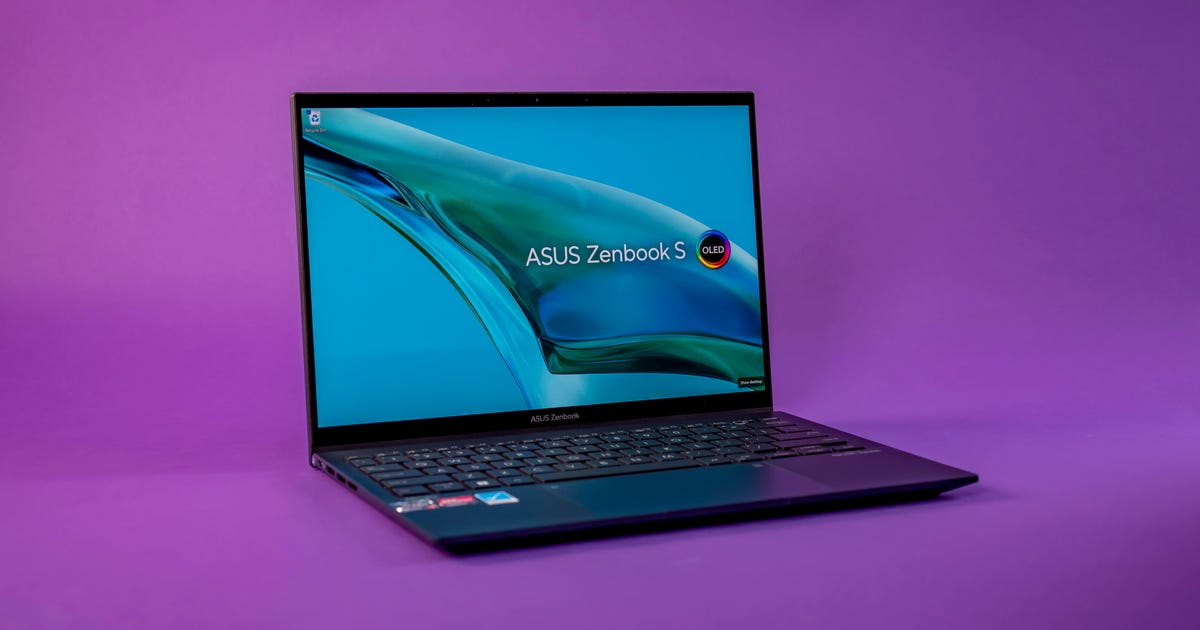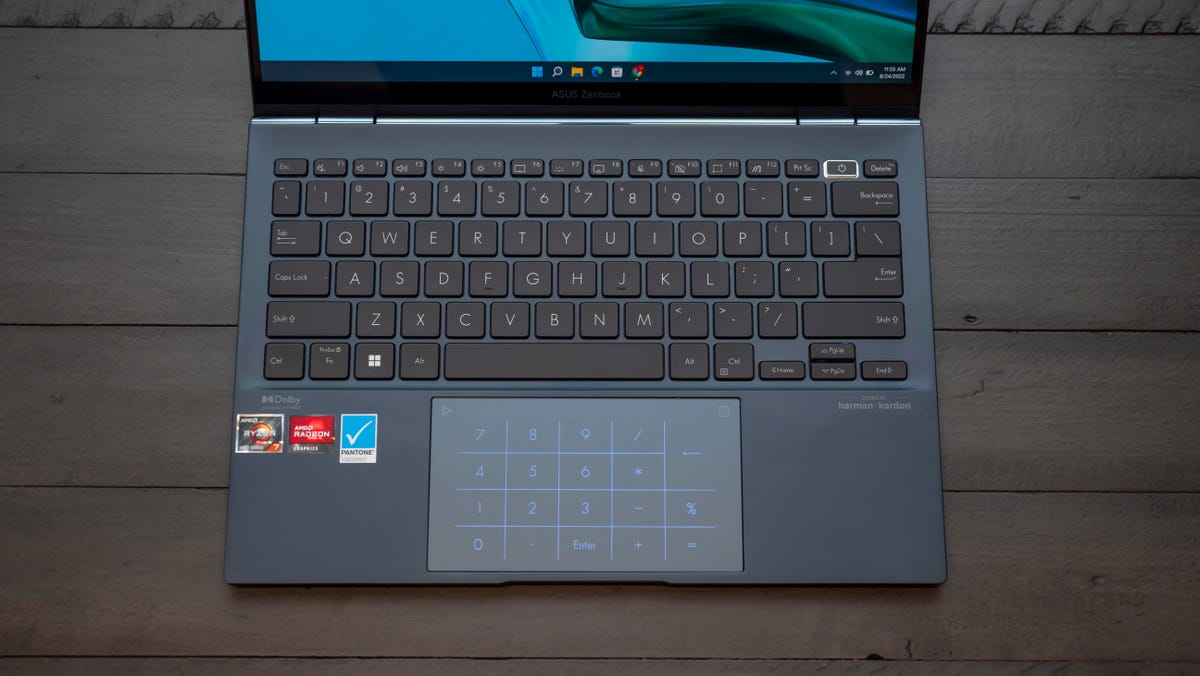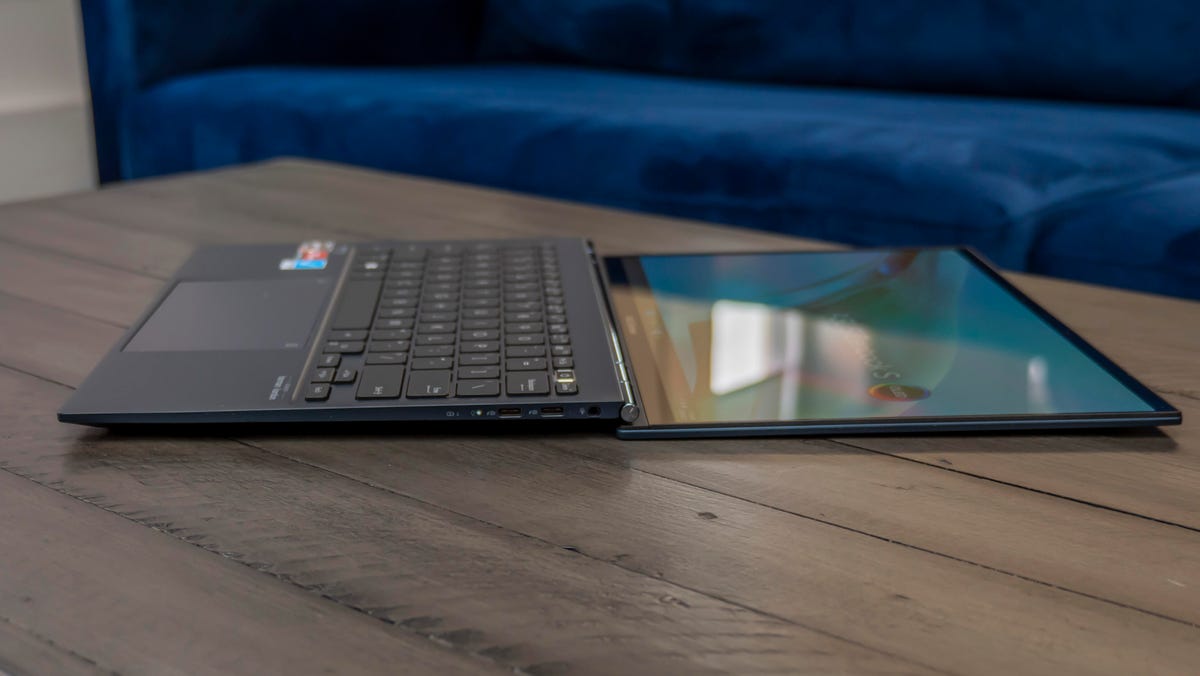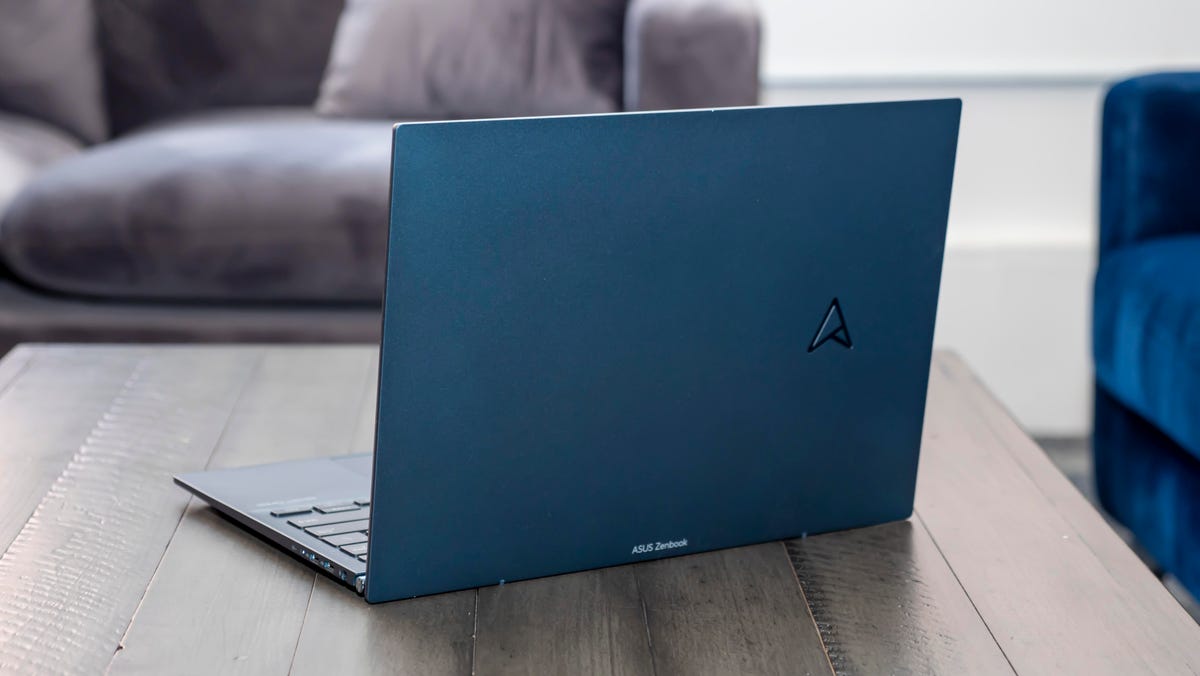
Asus Zenbook S 13 OLED (UM5302) Review: Superb runt Ultralight Laptop
It is not easy to find an ultralight laptop that tranquil feels sturdy but Asus pulls it off with the Zenbook S 13 OLED. At 1 kilogram (2.4 pounds), the 13.3-inch laptop is lighter than the MacBook Air (M1 and M2) — ideal for tossing in a backpack or shoulder bag deprived of a second thought. Despite its compact footprint, Asus squeezed in a vast keyboard and a big touchpad that doubles as a number pad when you need it. The 2.8K-resolution OLED short-tempered display is exquisite for productivity, entertainment and creative doings, too. And although OLED screens typically put a big hurt on battery life, that’s not the case here with the Zenbook S 13 OLED sketch more than 12 hours during our streaming video test.
Like
-
Ultralight design -
Long battery life -
Great-looking OLED display
Don’t Like
-
Gets hot during use, as does its shrimp power adapter -
720p webcam -
Currently in short-tempered supply
Overall performance is ringing from its AMD Ryzen 7 6800U processor backed with 16GB of fast DDR5 memory and an equally hasty 1TB SSD, keeping it competitive with others in its class such as the MacBook Air M2, Dell XPS 13 Plus and Acer Swift 5. (Check out the benchmark test results at the end of this review.) The sketch is these components put out a lot of heat when the laptop gets cranking. Even with the fans blowing full bore, the bottom of the Zenbook S 13 will roast your lap. When you need the laptop’s full considerable, use it on a desk.
Asus Zenbook S 13 OLED (UM5302)
| Price as reviewed | $1,300 |
|---|---|
| Display size/resolution | 13.3-inch 2,880×1,800 OLED testy display |
| CPU | 2.7GHz AMD Ryzen 7 6800U |
| Memory | 16GB DDR5 6,400MHz RAM |
| Graphics | 512MB AMD Radeon Graphics |
| Storage | 1TB NVMe PCIe 4.0 SSD |
| Connections | USB-C (x3, USB 3.2 Gen 2), 3.5mm combo audio jack |
| Networking | Wi-Fi 6E (802.11ax), Bluetooth 5.0 |
| Operating system | Windows 11 Pro 21H2 |
The ultralight magnesium-aluminum alloy chassis execute, the OLED display and high-quality components mean the Zenbook S 13 isn’t cheap; the configuration I tested is $1,300 (£1300, AU$1,661). Consider the 14-inch HP Pavilion Plus if you don’t mind distributing some extra size, weight and less battery life to save a few hundred bucks. The bigger issue is that even if you want to expend the money for the Asus, you might not be able to find one. As of this study, the laptop is listed on Best Buy, Amazon and B&H but only the last one seems to have stock.

Press the calculator icon in the upper luminous corner of the touchpad to turn on Asus’ NumberPad 2.0 feature.
Josh Goldman
Asus always does a astronomical job of packing some extra features into its laptops to help them infamous out. You might be attracted to the brilliant and lively OLED, the 1kg weight and speedy components, but it’s things like Asus’ NumberPad 2.0 that make the difference. Tap on the calculator icon in the touchpad’s upper luminous corner and a number pad appears on the touchpad so you can snappily input numbers or bang out a calculation or two. Plus, the software can tell the difference between entering numbers and comical it as a touchpad, so you don’t have to turn the feature on and off.
Then there’s Asus’ GlideX app, which mirrors or extends the Zenbook’s explain onto an Android tablet or phone, or an iPhone or iPad — wired or wirelessly. Install the complementary Android or iOS app on your visited or tablet and after a simple setup, your mobile arrangement is now an extra screen for the laptop. The mirroring option establishes it possible to use mobile apps on the Zenbook’s cloak, too.

The explain opens 180 degrees and supports an Asus active pen.
Josh Goldman
The Zenbook S 13 OLED also has toiling row hotkeys for taking screenshots and instantly killing the built-in mics and webcam to help defensive privacy. Speaking of, the webcam is just 720p instead of the 1080p cams unfounded in most premium laptops now. However, while it allows you less detail than a higher-resolution camera, the overall relate quality is quite good. The speakers sound surprisingly full, too, helped by Dolby Atmos.
Other nice touches included a fingerprint reader built into the power, support for comic Asus’ active pen on the touchscreen and, though the laptop only has three high-speed USB-C, Asus includes a USB-C-to-USB-A adapter as well as a laptop sleeve. Even the ultracompact 65-watt USB-C fast-charge adapter is nice (though like the laptop it gets elegant hot while charging).

Josh Goldman
The Asus Zenbook S 13 OLED is just a obedient little laptop. If you want something lighter than a MacBook Air with a wide vivid gamut display, good performance and battery life and a smattering of convenient features, it’s an easy recommendation. Here’s hoping Asus can get supply up so republic can more easily find it.
How we test computers
The reconsideration process for laptops, desktops, tablets and other computer-like devices consists of two parts: performance testing notion controlled conditions in the CNET Labs and extensive hands-on use by our permission reviewers. This includes evaluating a device’s aesthetics, ergonomics and features. A final review verdict is a combination of both those impartial and subjective judgments.
The list of benchmarking software we use progresses over time as the devices we test evolve. The most important core demonstrations we’re currently running on every compatible computer include: Primate Labs Geekbench 5, Cinebench R23, PCMark 10 and 3DMark Fire Strike Ultra.
A more detailed description of each benchmark and how we use it can be spurious in our How We Test Computers page.
Geekbench 5 (multicore)
Acer Swift 5 (SF514-56T-797T)
Lenovo Yoga 9i (14-inch, Gen 7)
Apple MacBook Air (13-inch, M2, 2022)
Dell XPS 13 Plus 9320
Asus Zenbook S 13 OLED
Note:
Longer bars prove better performance
Cinebench R23 CPU (multicore)
Acer Swift 5 (SF514-56T-797T)
Dell XPS 13 Plus 9320
Asus Zenbook S 13 OLED
Lenovo Yoga 9i (14-inch, Gen 7)
Apple MacBook Air (13-inch, M2, 2022)
Note:
Longer bars prove better performance
PCMark 10 Pro Edition
Asus Zenbook S 13 OLED
Lenovo Yoga 9i (14-inch, Gen 7)
Acer Swift 5 (SF514-56T-797T)
Dell XPS 13 Plus 9320
Note:
Longer bars prove better performance
3DMark Wild Life Extreme
Apple MacBook Air (13-inch, M2, 2022)
Dell XPS 13 Plus 9320
Lenovo Yoga 9i (14-inch, Gen 7)
Acer Swift 5 (SF514-56T-797T)
Asus Zenbook S 13 OLED
Note:
Longer bars prove better performance
Streaming video playback battery drain test (minutes)
Apple MacBook Air (13-inch, M2, 2022)
Asus Zenbook S 13 OLED
Lenovo Yoga 9i (14-inch, Gen 7)
Acer Swift 5 (SF514-56T-797T)
Note:
Longer bars prove better performance
System Configurations
| Asus Zenbook S 13 OLED | Windows 11 Pro; 2.7GHz AMD Ryzen 7 6800U; 16GB DDR5 6,400MHz; 512MB AMD Radeon Graphics; 1TB SSD |
|---|---|
| Dell XPS 13 Plus 9320 | Windows 11 Home; 1.8GHz Intel Core i7-1280P; 16GB DDR5 6,400MHz RAM; 128MB Intel Iris Xe Graphics; 512GB SSD |
| Apple MacBook Air (13-inch, M2, 2022) | MacOS Monterey 12.4; Apple M2 8-core chip; 8GB RAM; Apple 10-core GPU; 256GB SSD |
| Acer Swift 5 (SF514-56T-797T) | Windows 11 Home; 1.8GHz Intel Core i7-1280P; 16GB DDR5 6,400MHz RAM; 128MB Intel Iris Xe Graphics; 512GB SSD |
| Lenovo Yoga 9i (14-inch, Gen 7) | Windows 11 Home; 2.1GHz Intel Core i7-1260P; 16GB DDR5 5.200GHz RAM; 128MB Intel Iris Xe Graphics; 512GB SSD |
Asus Zenbook S 13 OLED (UM5302) Review: Superb Little Ultralight Laptop. There are any Asus Zenbook S 13 OLED (UM5302) Review: Superb Little Ultralight Laptop in here.
About Me
Total Pageviews
Search This Blog
Blog Archive
-
-
-
-
-
- Police Arrest Suspected Hackers in Wake of Lapsus$...
- FBI remotely installs spyware to trace bomb threat
- Between Glasses, Phone and Drone, Snap Aims to Bla...
- Razer Kishi V2 for iPhone Review: A Solid Game Con...
- WhatsApp changes Last Seen feature, hides from str...
- NSA spyware gives agency full access to the iPhone...
- Send YouTube Links as Stickers Directly Through Sn...
- 2022 Ford Bronco Everglades Review: Form Begets Fu...
- BlackBerry Messenger is dead: Use these apps insteadl
- Amnesty anti-spyware app tells you if the governme...
- Snapchat expands efforts to protect teens from dru...
- Vizio M-Series Quantum X Review: Bright HDR Pictur...
- Americans spent a third of waking hours on mobile ...
- Apple, long a champion of consumer privacy, now si...
- Snapchat Wants to Put You in the Director's Seat W...
- Xgimi Halo Plus Portable Projector Review: Big Pic...
- Europe's last dictator has a YouTube probleml
- A Fake Job Offer Reportedly Led to Axie Infinity's...
- Google's $100 Million Photo Privacy Settlement: Yo...
- 'Elvis' Review: Over-the-top Biopic Is Streaming N...
- WhatsApp Expands Emoji Reactions for Further Messa...
- Meta, formerly Facebook, bans seven 'surveillance ...
- Percentage of Teens Who Say They're 'Almost Consta...
- 'Tolkien' Review: 'Lord of the Rings' Biopic Revea...
- WhatsApp delays privacy update following concerns ...
- Stalkerware sees all, and US laws haven't stopped ...
- Snapchat Launches Paid Version With Extra Features
- Galaxy Z Fold 4 Review: Why I Can't Get Enough of ...
- Why WhatsApp users are pushing family members to S...
- SuperAntiSpyware Free Edition - Free download and ...
- You Can Finally Use Snapchat on Your Computer, but...
- Asus Zenbook S 13 OLED (UM5302) Review: Superb Lit...
-
-
-
-
